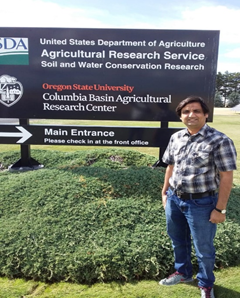Using a Tier II Model (CQESTR) to Predict SOC Storage and CO2 Emissions by Adnan Zahid, 2019 CLIFF-GRADS Recipient
Adnan, from Pakistan completed his CLIFF-GRADS research visit at the USDA-ARS Soil and Water Conservation Unit, under Dr. Hero Gollany. He is in the final stages of his PhD at the University of the Punjab in Pakistan.

The basic objective of my training was to learn the CQESTR model and apply it to my PhD research data for its calibration and validation. My supervisor, Dr.Hero Gollany and Robert Wayne Polumsky, Physical Science Technician, guided me in a friendly and learning environment. After successfully completing my training, I can now use the Tier-II CQESTR model along with the DSSAT-Century model that I had been using in my PhD. The DSSAT-Century model is used for soil organic carbon modelling under conventional and conservation tillage in rice-wheat cropping system in Pakistan. It was a splendid learning experience for me to enhance my knowledge about soil modelling and carbon sequestration. The future outcome of this training will be depicted in my upcoming publications and research projects in my country.
From my CLIFF-GRADS training I learned new skills, knowledge and was motivated to continue to work in this field for my country. Just after my return to my home country, I convinced the director of my institute (Institute of Agricultural Sciences-IAGS) and Vice-Chancellor of my university (University of the Punjab, Lahore) to establish a climate change research lab and awareness centre. As a result, we inaugurated the first climate change awareness centre in December 2019 for students, farmers and researchers for training on climate change and modelling at Institute of Agricultural Sciences, University of the Punjab, Lahore, where a laboratory for climate change research is being established.
Currently, I am completing a PhD on ‘Modelling dynamics of soil organic carbon under conventional and conservation tillage in rice-wheat cropping system in Pakistan’. The aim of my work is to predict the soil quality loss by conventional tillage practices and protect it by climate smart techniques i.e. conservation tillage techniques. This project will help policy makers to implement mitigation techniques to reduce greenhouse gas emissions from puddled rice, which is the main contributor in greenhouse gases in South Asia and also conserve Basmati Rice land for future generations, under a changing climate.
The CLIFF-GRADS training provided me the platform to explore new research ideas, develop scientific connections and new friends from all over the world. I am very thankful for the CLIFF-GRADS award as it has provided me with such a splendid learning opportunity.
